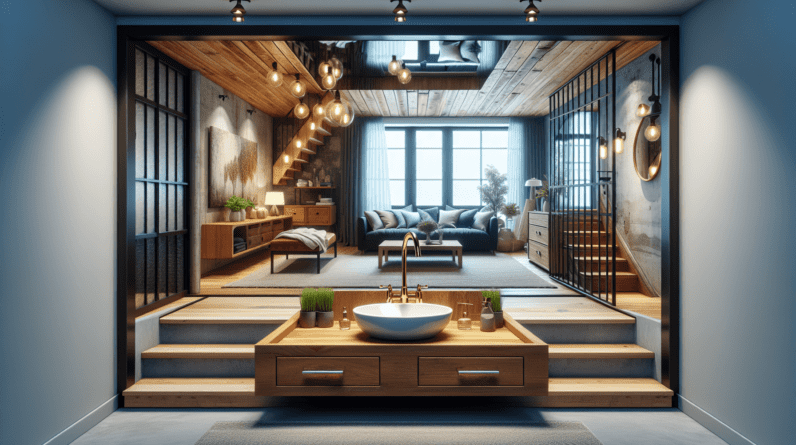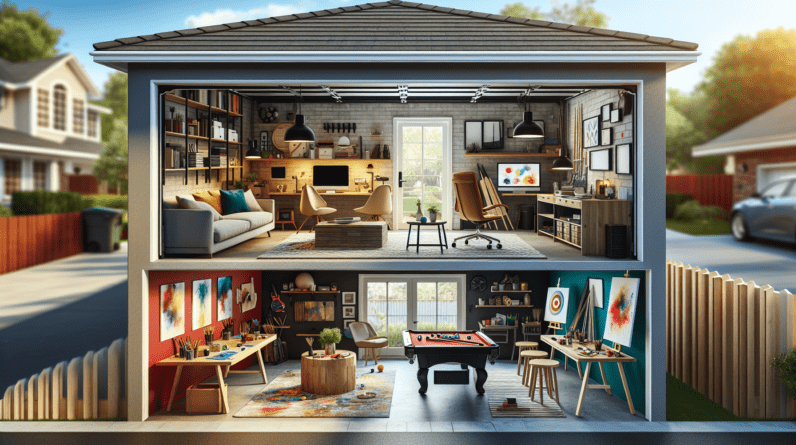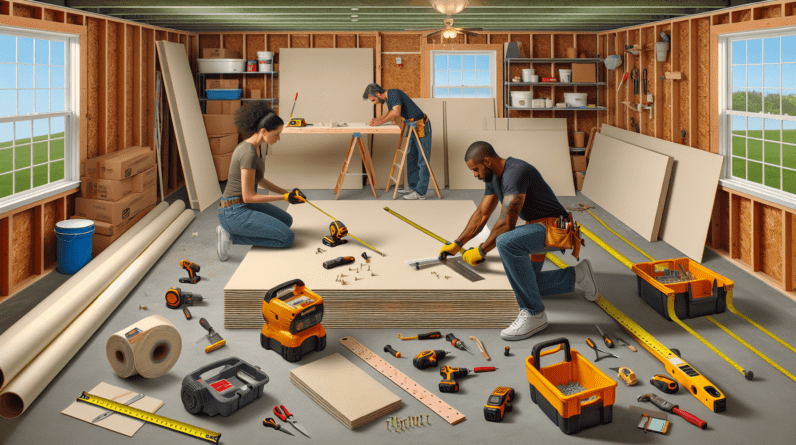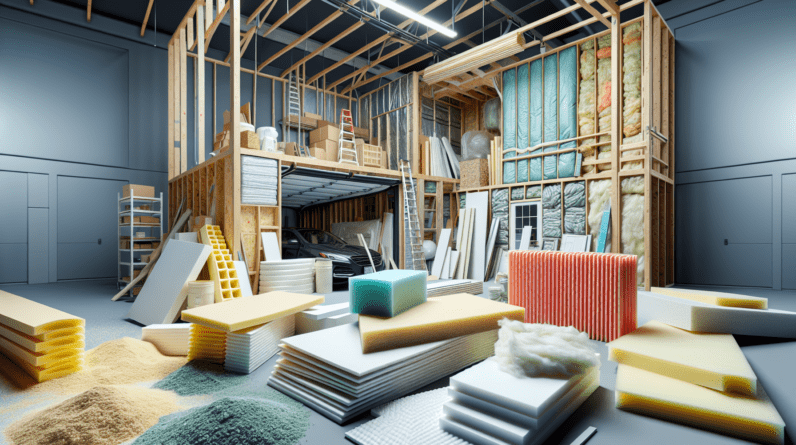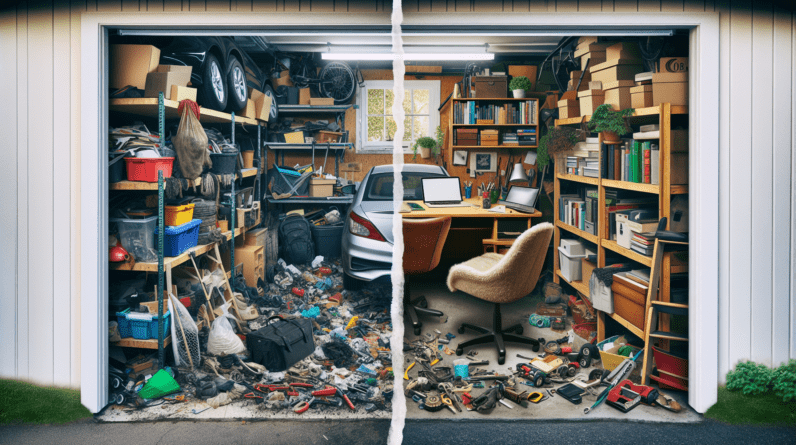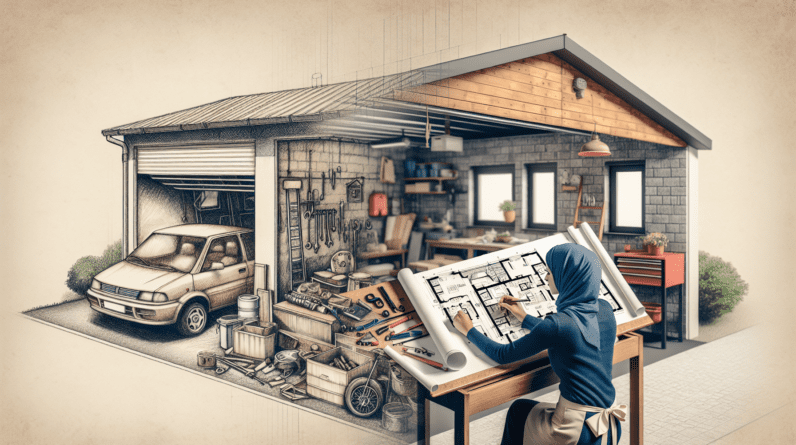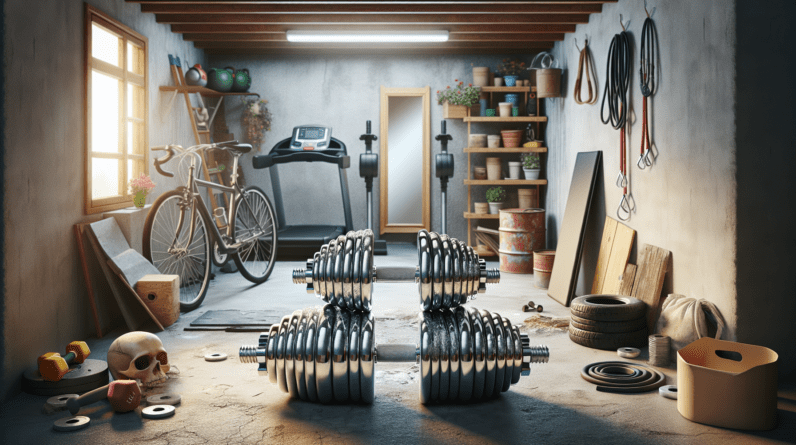
Thinking about converting your garage into a home gym? Well, the good news is that it’s definitely possible to do it yourself! With a little bit of planning, hard work, and some basic knowledge, you can transform that dusty old car space into your own personal workout haven. Whether you’re a fitness enthusiast looking to save money on gym memberships or simply want the convenience and privacy of exercising at home, converting your garage is a great option. In this article, we’ll explore some key factors to consider, from budgeting and equipment selection to ventilation and flooring options, to help you successfully tackle this exciting DIY project. So, put on your work gloves and get ready to turn your garage into the ultimate home gym!
Benefits of Converting a Garage into a Home Gym
Health and Fitness Convenience
Converting your garage into a home gym offers unparalleled convenience for your health and fitness routine. With a gym just a few steps away from your living space, you can effortlessly incorporate exercise into your daily life. No more commuting to the gym or waiting for equipment to become available – your workouts can now fit seamlessly into your schedule. Whether it’s a quick morning workout or a late-night exercise session, having a home gym allows you to prioritize your health without any hassle.
Saving Money on Gym Memberships
One of the most significant advantages of transforming your garage into a home gym is the potential cost savings it offers. Gym memberships can be quite expensive, especially if you opt for high-end facilities or specialty classes. By eliminating the need for a gym membership, you can save a substantial sum of money over time. Additionally, you won’t have to worry about additional expenses like gas or parking fees associated with going to the gym. Converting your garage into a home gym provides a budget-friendly alternative that allows you to invest in your health without breaking the bank.
Increased Privacy
For many people, working out in a public gym can be intimidating and uncomfortable. Whether it’s the fear of judgment or a desire for privacy, some individuals prefer a more secluded environment for their fitness endeavors. Converting your garage into a home gym provides you with the privacy you desire. You can exercise freely without feeling self-conscious or observed by others. This increased privacy can help you to stay focused and motivated, leading to a more effective and enjoyable workout experience.
Personalized Space
Turning your garage into a home gym allows you to create a space that is tailored to your specific fitness needs and preferences. You have full control over the layout, equipment selection, and décor, enabling you to design a personalized environment that inspires and motivates you. Customizing your home gym to reflect your style and preferences can enhance your overall workout experience, making it more enjoyable and encouraging you to consistently stay on track with your fitness goals.
Uninterrupted Workout Sessions
In a traditional gym setting, it’s not uncommon to experience interruptions or distractions that can disrupt your workout flow. From crowded spaces to excessive noise or waiting for equipment, these interruptions can significantly impact the efficiency and enjoyment of your exercise routine. Converting your garage into a home gym eliminates these potential distractions, allowing you to have uninterrupted workout sessions. You can fully focus on your exercises, maintain your flow, and maximize the effectiveness of each session.
Boost in Property Value
Transforming your garage into a home gym not only benefits your personal fitness journey but can also have a positive impact on the value of your property. A well-designed and functional home gym is a valuable asset that can attract potential buyers when it’s time to sell your home. Prospective homeowners appreciate the versatility and convenience of having a designated fitness space, which can increase the desirability and marketability of your property. Converting your garage into a home gym is a smart investment that can yield returns in both personal fitness and property value.
Assessing the Feasibility of the Conversion
Analyzing Available Space
Before embarking on the conversion process, it’s crucial to assess the available space in your garage. Measure the dimensions of the area, including ceiling height and any structural limitations such as columns or supports. Understanding the available space will help you plan the layout efficiently and determine the amount and types of equipment you can comfortably fit.
Checking Local Regulations and Permits
It’s essential to research and familiarize yourself with any local regulations and permits that may govern garage conversions in your area. Some jurisdictions may have specific requirements or restrictions regarding the conversion of a garage into a living space. Contact your local building department or consult with a professional to ensure compliance with all necessary regulations.
Evaluating Structural Integrity
Before proceeding with a garage conversion, evaluate the structural integrity of the existing garage. Look for any signs of damage or issues that may require repairs, such as cracks in the walls or foundation. Addressing any structural issues before beginning the conversion process will ensure the safety and longevity of your home gym.
Consideration of Ventilation and Temperature Control
Proper ventilation and temperature control are essential factors to consider when converting a garage into a home gym. Garages can often become hot and stuffy, especially during warm weather. Evaluate the existing ventilation system and explore options for improving airflow, such as installing windows or adding mechanical ventilation systems. Additionally, consider insulation and temperature control solutions to maintain a comfortable environment for your workouts throughout the year.
Determining Electrical and Lighting Requirements
Assess the electrical and lighting requirements of your desired home gym setup. Evaluate the existing electrical infrastructure in your garage and consult with a professional electrician to ensure it can support the electrical demands of gym equipment. Determine the ideal placement of outlets and consider installing adequate lighting fixtures to ensure a well-lit, safe workout space.
Assessing Flooring and Insulation
Evaluate the condition of your garage floor and determine if any repairs or upgrades are necessary. Choose a suitable flooring option for your home gym that provides traction, shock absorption, and durability. Consider materials such as rubber flooring, interlocking foam tiles, or hardwood alternatives that can withstand the demands of exercise equipment and intense workouts. Additionally, insulation should be considered to maintain a comfortable temperature and reduce noise transfer within the space.

Essential Equipment and Layout Planning
Selecting Suitable Gym Equipment
When converting your garage into a home gym, selecting suitable equipment is essential. Assess your fitness goals, preferences, and budget to determine the type and quantity of equipment that will best support your workouts. Consider versatile options like dumbbells, resistance bands, and kettlebells, as well as larger pieces such as cardio machines or a weightlifting rack, depending on your specific needs.
Considering Storage Solutions
Efficient storage solutions are crucial for maintaining an organized and clutter-free home gym. Incorporate storage options such as shelving units, wall-mounted racks, or storage bins to keep your equipment and accessories neatly stored and easily accessible. Utilize the vertical space in your garage to maximize storage capacity and maintain a clean and functional workout area.
Ensuring Sufficient Lighting
Ample lighting is essential for a safe and enjoyable workout experience. Ensure that your home gym is well-lit by incorporating a combination of natural and artificial lighting sources. Consider installing windows or skylights to take advantage of natural sunlight, along with overhead lighting fixtures and task lighting for specific areas such as weightlifting or cardio spaces.
Creating an Inspiring Environment
Designing an inspiring environment in your home gym can greatly enhance your motivation and enjoyment during workouts. Personalize the space with motivational quotes, artwork, or photographs that resonate with your fitness goals and aspirations. Choose a color scheme and decor that reflects your style and energizes you. Incorporate mirrors to create an illusion of space and allow for proper form and technique checks.
Maximizing Space with Adjustable Equipment
To optimize the functionality of your home gym, consider investing in adjustable equipment. Adjustable dumbbells, benches, or weightlifting racks allow for versatility in your workouts while minimizing the amount of space required. These flexible options can accommodate a variety of exercises and fitness levels without compromising the overall layout and flow of your home gym.
Planning for Safety Measures
Safety should always be a top priority when designing a home gym. Ensure that the layout allows for unobstructed movement and ample space around equipment. Install safety features such as rubber floor mats to minimize the risk of injury due to slips or falls. Consider adding a first aid kit, fire extinguisher, and appropriate safety signage to promote a safe workout environment.
Garage Conversion DIY or Hiring Professionals?
Cost Analysis – DIY vs. Professional Help
When deciding whether to embark on a DIY garage conversion or hire professionals, it’s crucial to conduct a cost analysis. Assess the budget you have available, considering the costs of materials, equipment, permits, and potential labor. Compare this to the estimates provided by professionals to determine which option is more financially feasible for you.
Skills and Knowledge Required for a DIY Conversion
Converting a garage into a home gym requires a certain level of skills and knowledge in various areas such as construction, electrical work, and plumbing. Assess your own capabilities and determine if you have the necessary expertise to successfully complete the conversion. Undertaking a DIY project without the required skills may result in subpar results or safety hazards.
Time and Effort Considerations
Converting a garage into a home gym, whether DIY or with professional help, requires a significant investment of time and effort. Consider the demands of your schedule and whether you have the availability to commit to the project. DIY conversions can often take longer, as you may need to research and learn new skills or face unexpected challenges along the way.
Safety Concerns with DIY Conversions
Safety is a critical consideration when opting for a DIY garage conversion. Working with electrical systems, plumbing, and heavy equipment poses potential risks if proper precautions are not taken. Hiring professionals eliminates these safety concerns and ensures that all work is done according to industry standards and codes, mitigating potential hazards.
Benefits of Hiring Professionals
While a DIY garage conversion can be fulfilling, hiring professionals can offer numerous benefits. Professionals bring their expertise, experience, and specialized knowledge to the project, ensuring a high-quality result. They can navigate complex regulations, obtain necessary permits, and complete the conversion efficiently. Hiring professionals also provides the peace of mind that the conversion will be safe, compliant, and durable.
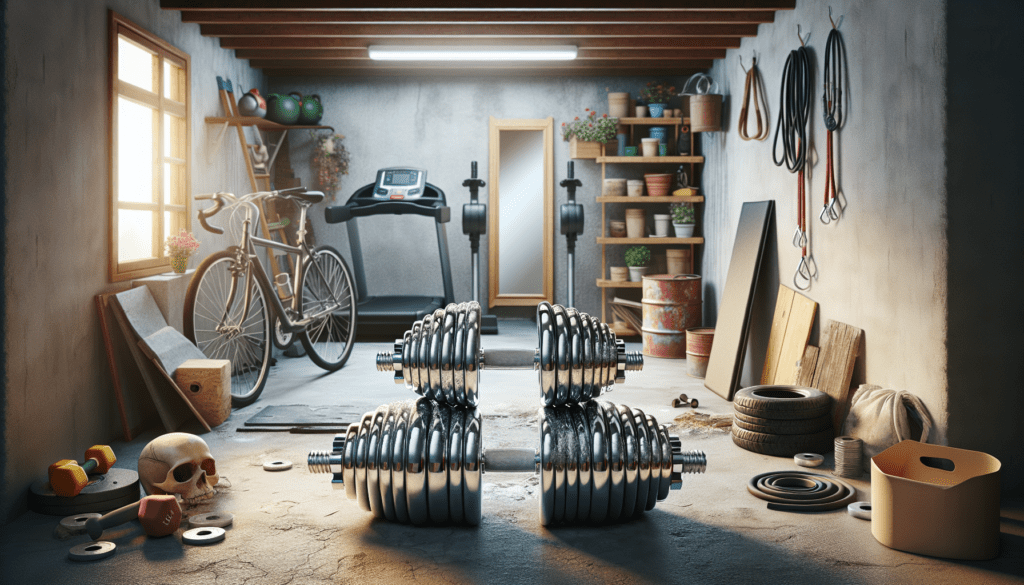
Step-by-Step Guide for DIY Garage Conversion
Clearing and Cleaning the Garage Space
Begin the conversion process by clearing out the garage space, removing any existing items or clutter. Clean the area thoroughly, including the floors, walls, and windows, to provide a fresh canvas for the transformation.
Insulating and Weatherproofing
Insulating and weatherproofing your garage is vital to maintain a comfortable and energy-efficient home gym. Install insulation in the walls, ceiling, and potentially the floors to regulate temperature and minimize external noise. Weatherproof doors and windows to prevent drafts and potential energy loss.
Addressing Plumbing and Electrical Needs
If you plan to incorporate a sink, bathroom, or shower in your home gym, address the plumbing requirements accordingly. Consult with a professional plumber to ensure proper installations and adherence to local codes. Similarly, consult with an electrician to meet the electrical needs of your gym, ensuring all wiring is safe and up to code.
Installing proper Flooring
Choose a suitable flooring option for your home gym based on your needs and budget. Install it according to the manufacturer’s instructions to ensure proper performance and durability. Consider adding foam or rubber floor mats to areas where heavy weights will be used for additional protection.
Adding Suitable Lighting
Install adequate lighting fixtures to ensure a well-lit and inviting workout space. Combine natural light with artificial lighting options, including overhead lights, task lights, and accent lighting, to create a balanced and functional lighting scheme.
Setting Up Gym Equipment
Place your selected gym equipment strategically to optimize the layout and flow of your home gym. Ensure that each piece of equipment has sufficient space and accessibility. Consider organizing equipment based on their usage frequency or exercise categories for ease of use.
Organizing Storage Solutions
Implement storage solutions to keep your gym equipment, accessories, and other items organized and easily accessible. Utilize wall-mounted racks, shelving units, or storage bins to efficiently store items while maximizing space.
Decorating and Personalizing the Space
Finalize your garage gym conversion by adding personal touches and aesthetic elements. Hang motivational artwork, inspirational quotes, or mirrors to create a visually appealing and motivating environment. Incorporate any additional decor that aligns with your fitness goals and inspires you to reach new heights.
Considerations for Electrical and Lighting
Understanding Electrical Wiring Requirements
Ensure a solid understanding of the electrical wiring requirements for your home gym. Consult with a professional electrician to evaluate the existing electrical infrastructure and assess if any upgrades or modifications are necessary. Adhering to local electrical codes is crucial to ensure safety and proper functionality.
Determining Power Needs for Gym Equipment
Different gym equipment may have varying power requirements. Consult equipment manuals or contact manufacturers to determine the necessary power capacity for each item. Ensure that your electrical system can accommodate the demands of all the equipment to prevent power outages or electrical issues.
Adding Sufficient Lighting Fixtures
A well-lit home gym is essential for a safe and enjoyable workout experience. Evaluate the existing lighting in your garage and determine if additional fixtures are necessary. Ensure that the lighting design provides adequate illumination for all workout areas, minimizing shadows and reducing the risk of accidents.
Working with Electrical Codes and Safety Precautions
Working with electrical systems requires strict adherence to electrical codes and safety precautions. Ensure that all wiring jobs are done by a licensed electrician who is knowledgeable about local building codes. Proper grounding, wire sizing, and appropriate circuit breakers are crucial for safety and to prevent electrical hazards.
Consulting Experts for Complex Electrical Tasks
For complex electrical tasks, such as installing specialty lighting or multiple power outlets, it’s recommended to consult with a professional. Electrical experts can guide you through the process, ensuring that your home gym’s electrical system is safe, reliable, and efficient. Trusting a professional will give you peace of mind and minimize the risk of errors or safety hazards.
Flooring Options for a Home Gym
Types of Gym Flooring Materials
Several flooring materials are suitable for a home gym, each with its own unique characteristics. Common options include rubber flooring, foam tiles, vinyl flooring, carpet tiles, and hardwood alternatives. Assess the specific requirements of your workouts, budget constraints, and personal preferences to choose the most appropriate flooring material.
Features and Pros/Cons of Various Options
Rubber flooring is popular for its durability, shock absorption, and noise reduction properties. Foam tiles offer cushioning, are easy to install, and versatile for various exercises. Vinyl flooring provides excellent water resistance and easy maintenance. Carpet tiles offer comfort and warmth but may not be suitable for heavy equipment. Hardwood alternatives provide an aesthetically pleasing and durable flooring option.
Consideration of Shock Absorption and Durability
When selecting a flooring material, prioritize factors like shock absorption and durability. High-impact workouts or weightlifting exercises necessitate flooring with excellent shock absorption capabilities to reduce the strain on joints and equipment. Opt for durable materials that can withstand the demands of heavyweights, repeated impacts, and vigorous exercise routines.
Budget-Friendly Flooring Alternatives
If budget constraints are a concern, there are affordable flooring alternatives available. Foam tiles and carpet tiles are relatively cost-effective choices, offering versatility and cost efficiency. Additionally, purchasing remnant materials or opting for discounted sales can help minimize expenses without compromising on quality.
Installation and Maintenance Tips
Follow the manufacturer’s instructions when installing your chosen flooring material. Ensure that all seams, corners, and edges are properly secured for a seamless and safe workout surface. Regular maintenance, such as sweeping, vacuuming, and occasional damp mopping, will help keep your flooring clean and well-maintained. Avoid using abrasive cleaners or equipment that may damage the flooring.
Garage Ventilation and Temperature Control
Importance of Proper Ventilation
Proper ventilation is crucial for maintaining a comfortable and healthy workout environment in your home gym. Ventilation helps remove excess humidity, odors, and stale air, providing fresh air circulation and preventing the buildup of harmful pollutants.
Mechanical Ventilation Systems
Consider installing mechanical ventilation systems to ensure consistent airflow and air quality in your home gym. Exhaust fans, air purifiers, or air conditioning units can help regulate temperature, humidity levels, and improve overall air circulation, creating a pleasant and comfortable workout space.
Natural Ventilation Options
If feasible, take advantage of natural ventilation options such as windows, skylights, or vents to introduce fresh outdoor air into your gym. Strategically placing these openings can facilitate cross-ventilation and enhance airflow, reducing the buildup of heat and odors.
Temperature Control Solutions
Garages can experience extreme temperature fluctuations, which may affect the comfort level of your home gym. Install insulation, weatherstripping, and energy-efficient windows and doors to minimize heat transfer and maintain a stable temperature. Consider additional temperature control solutions such as ceiling fans, portable heaters, or portable air conditioning units to create a pleasant workout environment year-round.
Managing Humidity and Air Quality
Humidity control is essential for preventing mold and mildew growth and maintaining a comfortable workout environment. Dehumidifiers can help remove excess moisture from the air, reducing the risk of dampness and musty odors. Additionally, regularly clean and maintain your home gym to promote good air quality and minimize dust accumulation.
Safety Precautions for The DIY Conversion
Inspecting and Repairing Structural Issues
Before beginning any DIY garage conversion, thoroughly inspect the structure for any signs of damage or structural issues. Address any concerns promptly to ensure the safety and stability of your home gym. Consult with a professional if extensive repairs are required.
Ensuring Adequate Lighting for Safety
Proper lighting is fundamental for safety in any home gym. Ensure that the entire space is well-lit, especially areas where exercises or equipment are located. Install additional lighting fixtures if necessary, paying attention to eliminate dark spots or shadows that can pose safety hazards.
Implementing Non-slip Flooring
Safety is paramount in a home gym, and preventing slips and falls is crucial. Choose a flooring material with non-slip properties, or add non-slip mats in areas prone to moisture or heavy equipment usage. Ensure that floor surfaces are kept clean and dry during workouts to minimize the risk of accidents.
Creating Emergency Exit Routes
When converting your garage into a home gym, establish clear emergency exit routes. Ensure that doors remain accessible and unobstructed at all times. Familiarize yourself and others with the location of emergency exits and ensure that they can be easily reached in the event of an emergency.
Installing Fire and Carbon Monoxide Detectors
Safety should always be a top priority, and installing fire and carbon monoxide detectors is crucial in a home gym. These devices can detect potential hazards and alert you to any immediate dangers, allowing you to respond promptly and ensure the safety of yourself and others.
Placing First Aid Kits and Safety Equipment
Accidents can happen, even in a well-designed home gym. Ensure that a fully stocked first aid kit is readily available in your home gym. Additionally, place other safety equipment such as fire extinguishers, emergency contact numbers, or AEDs (Automated External Defibrillators) in easily accessible locations.
Maintenance and Upkeep of the Home Gym
Regular Maintenance Tasks
To keep your home gym in the best condition, establish a regular maintenance routine. Inspect and clean the gym equipment, checking for any signs of wear and tear or potential malfunctions. Regularly clean the space, including floors, windows, and mirrors, to maintain a clean and hygienic environment.
Cleaning and Sanitizing the Equipment
Cleaning and sanitizing your gym equipment is not only essential for hygiene but also for prolonging the lifespan of the equipment. Use appropriate cleaning products and methods recommended by the manufacturers to ensure safe and effective cleaning without causing damage.
Addressing Equipment Repair and Replacement
As with any equipment, wear and tear over time are inevitable. Monitor your gym equipment for any signs of damage or malfunction and address them promptly. Regularly inspect cables, upholstery, and moving parts to identify potential issues, and consult with professionals for repairs or replacements as necessary.
Updating and Upgrading the Gym Setup
To keep your home gym engaging and motivating, consider updating and upgrading the gym setup periodically. Incorporate new exercises or equipment that align with your fitness goals and interests. Stay informed about fitness trends and advancements to ensure your home gym remains relevant and enjoyable.
Considering Professional Maintenance Services
If you prefer to have professional assistance in maintaining your home gym, consider hiring maintenance services specifically tailored for gym equipment. These professionals can perform routine maintenance tasks, equipment inspections, and preventative maintenance to keep your gym in optimal condition.
Converting a garage into a home gym offers numerous benefits, including convenience, cost savings, privacy, and increased property value. Assessing the feasibility of the conversion involves analyzing available space, checking local regulations, evaluating structural integrity, considering ventilation and temperature control, and determining electrical and lighting requirements.
Planning the essential equipment and layout involves selecting suitable gym equipment, considering storage solutions, ensuring sufficient lighting, creating an inspiring environment, maximizing space with adjustable equipment, and planning for safety measures.
Deciding between a DIY conversion or hiring professionals involves comparing the cost analysis, assessing required skills and knowledge, considering time and effort, addressing safety concerns, and acknowledging the benefits of professional help.
A step-by-step guide for a DIY garage conversion includes clearing and cleaning the space, insulating and weatherproofing, addressing plumbing and electrical needs, installing proper flooring, adding suitable lighting, setting up gym equipment, organizing storage solutions, and decorating and personalizing the space.
Considerations for electrical and lighting involve understanding wiring requirements, determining power needs, adding sufficient lighting fixtures, working with codes and safety precautions, and consulting experts for complex tasks.
Flooring options for a home gym include types of materials, features and pros/cons, consideration of shock absorption and durability, budget-friendly alternatives, and installation and maintenance tips.
Garage ventilation and temperature control involve understanding the importance of proper ventilation, mechanical and natural ventilation options, temperature control solutions, and managing humidity and air quality.
Safety precautions for the DIY conversion include inspecting and repairing structural issues, ensuring adequate lighting, implementing non-slip flooring, creating emergency exit routes, installing fire and carbon monoxide detectors, and placing first aid kits and safety equipment.
Maintenance and upkeep of the home gym involve regular tasks, cleaning and sanitizing equipment, addressing equipment repair and replacement, updating and upgrading the gym setup, and considering professional maintenance services.
By considering these factors and following the outlined steps, you can successfully convert your garage into a home gym that meets your fitness goals, preferences, and safety requirements. Enjoy the convenience, privacy, and personalization of your own dedicated fitness space, and reap the benefits of a healthy and active lifestyle.

